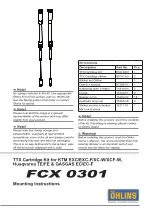
11
Joerns® Support Surface
FlapCair Model
© 2013 Joerns Healthcare • 6110066 RevD • 13-2631
Changing the Therapy Pad
• Place the therapy pad over the therapy cells, fitting
the corner of the cushions into the corner of the
therapy pad. (Similar to a fitted sheet.)
•
Zip the therapy pad along each side of the mattress
tub.
Patient Positioning and Comfort
General Repositioning
Patients should be turned and repositioned per
individual turning schedule or per facility policy. It may
be helpful to activate the
Autofirm
mode to achieve
a firm surface for repositioning purposes. The unit
will automatically return to the mode it was in prior
to
Autofirm
in approximately 12 minutes or you can
manually return to therapy mode once patient has
been repositioned.
Unless counter indicated, it is desirable to keep
the head of the bed in the low position to provide
optimal pressure relief and minimize the risk of
shearing injuries.
If using super flotation zones, always ensure wound
site is placed appropriately to ensure maximum
pressure relief.
Elevating Patient into Sitting Position
The special properties of the FlapCair, therapy pad
reduce the opportunity for shear and friction that may
occur when raising the head of other beds. As with any
surface, sliding can be expected, therefore patients
should be repositioned after elevation. The knee gatch
or foot of the bed may be elevated first, to help prevent
the patient from sliding when the head of the bed is
elevated.
Incontinence
Moisture against the skin surface leads to maceration,
or softening of the tissues. To prevent maceration, we
recommend you use an incontinence barrier pad to
absorb the excess moisture.
In the event of incontinence or excess drainage on the
therapy pad, you should wipe off the excess fluid from
the bed surface.
11
Safety Information
Patient Migration
Specialty bed products are designed to reduce/
relieve pressure and the shearing/friction forces on
the patient’s skin. The risk of gradual movement and/
or sinking into hazardous positions of entrapment and/
or inadvertent bed exit may be increased due to the
nature of these products.
Traction
With any traction or unstable fractures, maintain
physician-directed angle of articulation and guard
against risks of patient migration or inadvertent
deflation of patient surface.
Skin Care
Monitor skin conditions regularly, particularly in areas
where incontinence and drainage occur or collect,
and consider adjunct or alternative therapies for high
acuity patients. Early intervention may be essential to
preventing serious skin breakdown.
Bed Height
To minimize the risks of falls or injury the patient
surface should always be in the lowest practical
position when the patient is unattended. Make sure
areas under and around the frame are clear of objects,
persons and parts of body before adjusting height.
Cleaning
Warning:
Unplug the control unit from its power
source. Failure to do so could result in personal injury
or equipment damage.
Warning
: Do not expose the unit to excessive
moisture that would allow for liquid pooling. Personal
injury or equipment damage could occur.
Caution:
Do not use harsh cleansers/detergents, such
as scouring pads and heavy-duty grease removers, or
solvents, such as acetone. Equipment damage could
occur.
Control Unit
Wipe off dust. If necessary, clean the housing exterior
with a disinfectant solution or a mild detergent and a
damp cloth. Then wipe dry.
































